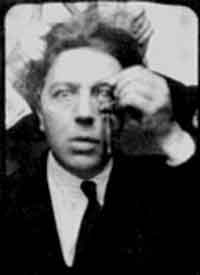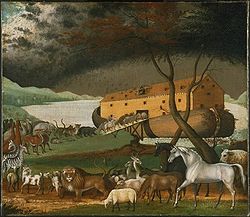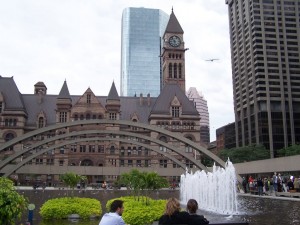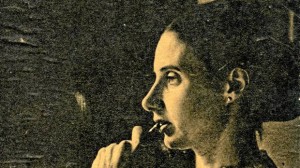Victoria’s Contribution to the Development of Canadian Culture
Northrop Frye
The following talk was presented at Victoria College on 10 November 1977. It has not been previously published. Although the talk seems to end abruptly, there is no indication in the typescript that additional material followed from what we have here.
My three predecessors in this series have built up a picture of a highly rational ethos and a lively atmosphere of debate and argument, sometimes good humoured and sometimes acrimonious. The axiom of any liberal arts college with a church connection must always be that faith and reason are complementary and not contradictory. When faith and reason collide, as unfortunately they keep doing with the greatest regularity, the community becomes polarized. By one group, reason is seen as undermining faith, and so, eventually, morals. By the other group, the insistence on faith which contradicts instead of fulfilling the demands of reason is seen as stifling all liberal knowledge and intellectual honesty. This issue became particularly acute in Victoria College after Darwinian evolution had begun to make its impact and the so-called “higher criticism” of the Bible had begun. Victoria adopted an “if you can’t lick ’em, join ’em” attitude to evolution. This approach to the Bible was preoccupied with the question of whether the account of Creation in Genesis was poetic or scientific. Many people in the Faculty of Theology had been trained in science, and brought to the study of the Bible minds that had been brought up in such areas as chemistry and biology.
For my purposes I have to begin with this issue, and isolate in it a cultural dimension, that I think is likely to be overlooked. The average Victoria student in the nineteenth century, coming from a Methodist background, found himself in a world that was split imaginatively rather than intellectually. In front of him was a tough, gritty, competitive world of nineteenth century Upper Canada. Tucked away in a corner of his mind, and given an airing on devotional occasions, was a world of magic, wonder and mystery, in which Jonah could spend three days in a fish’s belly and Elijah could go up to heaven in a chariot of fire. The split between the two worlds enabled most students to deal with the contemporary world before them very effectively on its own terms. But having the other world on their minds helped to keep a cultural balance.
The Massey family bulks very large in early Victoria history, and although Vincent Massey was a graduate of University College, he did a great deal for the Victoria community both during his term as Senior Tutor in Burwash and later. He became, of course, a major cultural influence for the whole of Canada, particularly through the Commission which he chaired, and which brought out the “Massey Report” in 1949. The introduction to this report, almost certainly written by Massey himself, spoke of the roots of cultural life in nineteenth century Canada, with strong emphasis on the role played by the church. He begins with a tribute to the expert and dedicated church organists who came from England to Canada. My own music teacher [George Ross] was, one of them, and I well remember how the congregation of St. John’s United Church in Moncton used to make their way out of the church with no notion that they were being wrapped up in something like the St. Anne’s Fugue. He then goes on to speak of the roots of literature:
Not only in music but in letters did the church make important contributions to the life of the community. The rector or the pastor of the church lectured on Dante or on Browning, on Victor Hugo or on Lewis Carroll; he was in wide demand with his lantern slides of London or the Holy Land, and in many of the smaller places his was the only library for many miles.
When I reread this, my eye paused on the phrase “lantern slides of the Holy Land.” It indicates the way in which the Bible was not simply a source of faith and morals, but an imaginative and cultural focus as well. The controversies between faith and reason are usually presented simply in their own terms, and as late as the novels of Grace Irwin, some of them written in 1969, that is how they were still being presented as the realities of faith colliding with the unrealities of human rationalizing. But I think that the cultural dimension in the display is in the long run more important. Perhaps the rationalizers and higher critics of the Bible, however admirable their motivation, did not realize the extent to which, in assigning the magic and miracle of the Bible to unreality, they were making the entire world as tough and gritty and competitive as the world of ordinary life.
One of the earlier poems of E. J. Pratt, which appeared in Newfoundland Verse, is called “The Epigrapher”:
His head was like his lore—antique,
His face was thin and sallow-sick,
With god-like accent he could speak
Of Egypt’s reeds or Babylon’s brick
Or sheep-skin codes in Arabic . . .
And every occult Hebrew tale
He could expound with learned ease,
From Aaron’s rod to Jonah’s whale.
He had held the skull of Rameses––
The one who died from boils and fleas . . .
From that time onward to the end,
His mind had had a touch of gloom;
His hours with jars and coins he’d spend,
And ashes looted from a tomb,—
Within his spare and narrow room . . .
And thus he trod life’s narrow way,—
His soul as peaceful as a river—
His understanding heart all day
Kept faithful to a stagnant liver.
This poem puzzled me for many years, partly because of the curious virulence of the tone, which was unusual for Pratt. What was it about epigraphers that he disliked so much? When the poem appeared, the best known scholars in that sort of area were Charles Currelly, whom I shall return to shortly, and S. H. Hooke, the great Old Testament scholar who after a somewhat turbulent career at Victoria College, went to the University of London. But neither of them had stagnant livers: Currelly was a person of extraordinary drive and energy, and Hooke was an athlete of professional competence in several areas, who was still writing books with unabated enthusiasm in his nineties. It seems to me that the antagonism is real to the kind of pedantry that unconsciously attempts to take out of life everything that the imagination needs to nourish it.
Again, in James Reaney’s play, Colours in the Dark, a certain Dr. Button is introduced, who lectures on the Bible and finds great delight in telling his students that the Bible contains nothing except the most primitive and repulsive forms of superstition. One distressed student says: “But don’t you believe in anything?” Dr. Button says: “No, not since I caught old Professor So-and-so putting twelfth‑century shards in a ninth‑century dig.” Here again the issue is presented as one of faith against reason, but the real issue is that of imagination against minimal reality.




